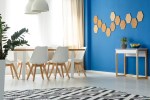In the end, color is choice of painter
Dear Gail: I'm painting my house, and a girlfriend said that all my ceilings, baseboards, doors and trim have to be all white. Is this a rule? Will I be making a decorating faux pas if I don't do white? — Thanks, Millie
Dear Millie: I do appreciate friend's suggestions and ideas because sometimes it's hard to see your own home in a different light, but I believe that it's your home at the end of the day, and you need to love it. It's how I operate my business. Anymore there are no hard and fast rules to decorating. The decorating police are not going to lock you up if you want your home to be uniquely yours. So here are four decorating myths we're going to bust.
Myth No. 1: Ceilings, doors and trim must be white.
White is that comfortable go-to color, it goes with everything. It's what the builder did so it must be right.
No, it's just the easiest for them to do as they can spray everything and not have to spend endless hours taping. White is clean and simple and, depending upon the light in your room, it will make the room appear taller but not all the time.
In small rooms, especially powder baths, I will paint the ceiling the same color as the walls. It actually extends the ceiling as your eye is not stopping at the color change. With crown molding, I always like to paint the ceiling something other than white so you can see the wonderful molding you invested in. I do still prefer white on popcorn ceiling.
Doors and trim can be a little trickier as I feel they should be a consistent color throughout the home when you see more than one at a time. But that doesn't necessarily mean white. The color you choose just has to work with the color scheme in your home.
I had a client that wanted all the front of the doors painted black and the backs white, all with white trim. It looked striking. I painted my door that goes from my laundry to my garage purple and I love it. My brother painted his doors and trim a sand color as the white showed everything. The color flowed great throughout the house.
Myth No. 2: Wood finishes should match.
I'm asked this question all the time: "Don't all my woods have to match?" No, they just need to complement each other.
You have to watch red tones with orange and yellow. Making them a contrast in both color and wood species works better than the same species. Watch that it doesn't look like you tried to match them but failed. If mixing wood tones scare you, then try painted furniture.
Mixing woods creates interest and depth to a room. Your eye travels through the room instead of just stopping in the middle.
Here's a little story because you know by now I love to share them. For years I wouldn't wear black and brown together; those colors just don't go together in clothing. Although I would have no problem putting black in a room with wood tones or doing a beautiful scheme with black and brown together.
I think it's because I grew up with my Mom only wearing the matching shirts to the pants she bought. Clothing manufacturer Alfred Dunner would introduce a new pant color and had all the matching shirts. The exact color of the pants were in all their matching shirts. To this day at 86 years old, she still can't mix and match. Glad to say I have stepped out of the box.
Myth No. 3: All the furniture in a room must be the same style.
Sorry, this is so boring. Furniture is sold in sets because the retailers receive a better price, plus it's an easier sale as most people are not comfortable mixing and matching. You don't need to have what I like to call a "room in a box" to have a beautifully designed room.
This is the same as the lamp sets where you get two table lamps, a floor lamp and then an accent lamp. The price is great but too matchy-matchy unless you split them up into different rooms.
In a bedroom, have the same chest and dresser with different nightstands. Do a different coffee table and console than your end tables. Do a different kitchen table and chairs versus the set. I find people are more comfortable with this mix and match than any other. It shouldn't be any different in your other rooms.
When clients want to buy a "room in a box," I always remember the "Friends" episode when Rachel bought a whole room just as it was in the Pottery Barn catalog. Someone else put it together, so it must work. Of course, with Pottery Barn it did.
Myth No. 4. Small rooms must be painted light colors.
Oh, how many times have I heard "It's a small room so I want to go light." My belief is that it's already a small room, so let's give it some life and interest.
I especially like to go bold in a powder bath. Think about it: How long does anyone stay in the room? They're not going to feel trapped in the few minutes they are in there.
Deep or bold colors will make the room dramatic and give it a larger-than-life presence. What's wrong with that? Remember it's just paint; come to the color side.
So, Millie, take a chance and bust the all-white myth. Start with one room and see how you feel. Maybe your girlfriend will see the light and make a change, too.
— Gail Mayhugh, owner of GMJ Interiors, is a professional interior designer and author of a book on the subject. Questions may be sent by email to: GMJinteriors@gmail.com. Or, mail to: 7380 S. Eastern Ave., No. 124-272, Las Vegas, NV 89123. Her Web address is: www.GMJinteriors.com.





























